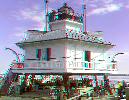Hooper Strait Lighthouse
Hooper Strait Light is one of four surviving Chesapeake Bay
screw-pile lighthouses in the U.S. state of Maryland. Originally located
in Hooper Strait, between Hooper and Bloodsworth Islands in Dorchester
County and at the entrance to Tangier Sound, it is now an exhibit at the
Chesapeake Bay Maritime Museum in St. Michaels, Maryland.
Lightships were stationed at this site beginning in 1827, including
one destroyed by confederate forces during the Civil War. In 1867 a
square screw-pile structure was erected. It survived only ten years; in
January 1877 ice tore the house loose and sent it floating down the bay.
The keeper John S. Cornwell and his assistant barely escaped using one
of the light's boats, and were trapped on the ice for 24 hours before
being rescued. In spite of frostbite, Cornwell said that "should there
be another house erected, or a boat placed in the site of the old one,
Capt. Conway [his assistant] and myself will be ready to take charge of
it[.]" Lighthouse tenders sent after the sunken house located it some
five miles (8 km) south of the strait and were able to salvage the lens,
lamp, and fog bell.
A new light was erected at the same location in 1879, another
screw-pile light of the then typical hexagonal form, with the house
being prefabricated at the Lazarretto Point depot. John Cornwell did in
fact become the first keeper of the new light. In 1882 a red sector was
fitted. This light remained manned until 1954, at which point it was
automated and the house boarded up.
In the 1960s the Coast Guard had taken to removing the houses from
the old screw-pile lights in order to cut maintenance costs and avoid
vandalism; a skeleton tower would then be erected on the old foundation.
The Hooper Strait Light was slated to be so treated in 1966, but the
newly founded Chesapeake Bay Maritime Museum arranged with the
Historical Society of Talbot County and the federal government to have
the light moved to its campus instead. The light was sliced in half at
its eaves, and the two pieces of the house were barged to St. Michaels,
where they were reassembled on a newly constructed foundation on Navy
Point. This was the first successful preservation effort of its kind in
the bay, laying a precedent for the removal and preservation of the Drum
Point and Seven Foot Knoll lights. The light remains a showpiece of the
museum and a landmark on the St.
W1, SPM, PS-CS6, IrfanView.
I was concerned about depth because of how far away I had to get to capture the entire lighthouse.
Cheers,
Brian
My Flickr page: http://www.flickr.com/photos/ur4chun8/
My photos according to "Interestingness"...
http://fiveprime.org/hivemind/Tags/Brian,Wallace,3d
Capture Outdoors Maryland: http://www.capturemaryland.com/users/Starg82343
 (896K)
(896K)